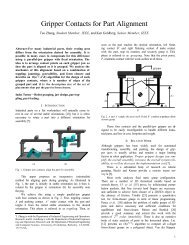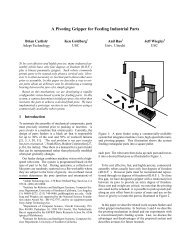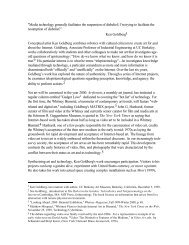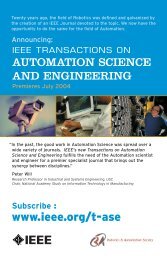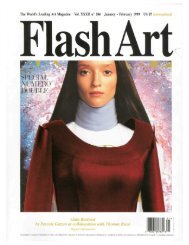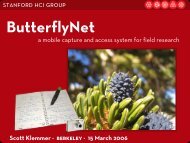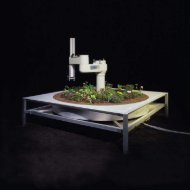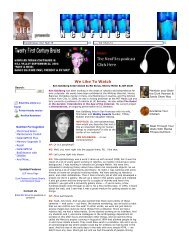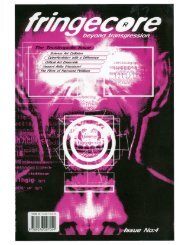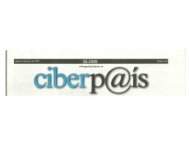0.5MB .pdf - Ken Goldberg - University of California, Berkeley
0.5MB .pdf - Ken Goldberg - University of California, Berkeley
0.5MB .pdf - Ken Goldberg - University of California, Berkeley
Create successful ePaper yourself
Turn your PDF publications into a flip-book with our unique Google optimized e-Paper software.
1372 THE INTERNATIONAL JOURNAL OF ROBOTICS RESEARCH / November/December 2008<br />
insertion with or without direction change). Second, we can<br />
determine the optimal needle insertion start pose by examining<br />
the pre-computed DP look-up table containing the optimal<br />
probability <strong>of</strong> success for each needle state, as demonstrated in<br />
Figure 7. Third, intra-operative medical imaging can be combined<br />
with the pre-computed DP look-up table to permit optimal<br />
steering <strong>of</strong> the needle in the operating room without requiring<br />
time-consuming intra-operative re-planning, as shown<br />
in Figure 9.<br />
Extending the motion planner to three dimensions would<br />
expand the applicability <strong>of</strong> the method. Although the mathematical<br />
formulation can be naturally extended, substantial<br />
effort will be required to geometrically specify threedimensional<br />
state transitions and to efficiently handle the<br />
larger state space when solving the MDP. We plan to consider<br />
faster alternatives to the general value iteration algorithm, including<br />
hierarchical and adaptive resolution methods (Chow<br />
and Tsitsiklis 1991 Moore and Atkeson 1995 Bakker et al.<br />
2005), methods that prioritize states (Barto et al. 1995 Dean<br />
et al. 1995 Hansen and Zilberstein 2001 Moore and Atkeson<br />
1993 Ferguson and Stentz 2004), and other approaches<br />
that take advantage <strong>of</strong> the structure <strong>of</strong> our problem formulation<br />
(Branicky et al. 1998 Bemporad and Morari 1999 Branicky<br />
et al. 1999).<br />
In future work, we also plan to consider new objective functions,<br />
including a weighted combination <strong>of</strong> path length and<br />
probability <strong>of</strong> success that would enable the computation <strong>of</strong><br />
higher risk but possibly shorter paths. We also plan to develop<br />
automated methods to estimate needle curvature and variance<br />
properties from medical images and to explore the inclusion<br />
<strong>of</strong> multiple tissue types in the workspace with different needle/tissue<br />
interaction properties.<br />
Our motion planner has implications beyond the needle<br />
steering application. We can directly extend the method to motion<br />
planning problems with a bounded number <strong>of</strong> discrete<br />
turning radii where current position and orientation can be<br />
measured but future motion response to actions is uncertain.<br />
For example, mobile robots subject to motion uncertainty with<br />
similar properties can receive periodic “imaging” updates from<br />
GPS or satellite images. Optimization <strong>of</strong> “insertion location”<br />
could apply to automated guided vehicles in a factory setting,<br />
where one machine is fixed but a second machine can<br />
be placed to maximize the probability that the vehicle will not<br />
collide with other objects on the factory floor. By identifying<br />
a relationship between needle steering and infinite horizon<br />
DP, we have developed a motion planner capable <strong>of</strong> rigorously<br />
computing plans that are optimal in the presence <strong>of</strong><br />
uncertainty.<br />
Acknowledgments<br />
This research was supported in part by the National Institutes<br />
<strong>of</strong> Health under award NIH F32 CA124138 to RA and NIH<br />
R01 EB006435 to KG and the National Science Foundation<br />
under a Graduate Research Fellowship to RA. Ron Alterovitz<br />
conducted this research in part at the <strong>University</strong> <strong>of</strong> <strong>California</strong>,<br />
<strong>Berkeley</strong> and at the UCSF Comprehensive Cancer Center,<br />
<strong>University</strong> <strong>of</strong> <strong>California</strong>, San Francisco. We thank Allison<br />
M. Okamura, Noah J. Cowan, Greg S. Chirikjian, Gabor<br />
Fichtinger and Robert J. Webster, our collaborators studying<br />
steerable needles. We also thank Andrew Lim and A. Frank<br />
van der Stappen for their suggestions, and clinicians I-Chow<br />
Hsu and Jean Pouliot <strong>of</strong> UCSF and Leonard Shlain <strong>of</strong> CPMC<br />
for their input on the medical aspects <strong>of</strong> this work.<br />
References<br />
Downloaded from<br />
http://ijr.sagepub.com at UNIV CALIFORNIA BERKELEY LIB on November 25, 2008<br />
Agarwal, P. K., Biedl, T., Lazard, S., Robbins, S., Suri, S. and<br />
Whitesides, S. (2002). Curvature-constrained shortest paths<br />
in a convex polygon. SIAM Journal <strong>of</strong> Computing, 31(6):<br />
1814–1851.<br />
Alagoz,O.,Maillart,L.M.,Schaefer,A.J.andRoberts,M.<br />
(2005). The optimal timing <strong>of</strong> living-donor liver transplantation.<br />
Management Science, 50(10): 1420–1430.<br />
Alterovitz, R., <strong>Goldberg</strong>, K. and Okamura, A. M. (2005a).<br />
Planning for steerable bevel-tip needle insertion through 2D<br />
s<strong>of</strong>t tissue with obstacles. Proceedings IEEE International<br />
Conference on Robotics and Automation (ICRA), pp. 1652–<br />
1657.<br />
Alterovitz,R.,Lim,A.,<strong>Goldberg</strong>,K.,Chirikjian,G.S.and<br />
Okamura, A. M. (2005b). Steering flexible needles under<br />
Markov motion uncertainty. Proceedings IEEE/RSJ International<br />
Conference on Intelligent Robots and Systems<br />
(IROS), pp. 120–125.<br />
Alterovitz, R., Pouliot, J., Taschereau, R., Hsu, I.-C. and <strong>Goldberg</strong>,<br />
K. (2003a). Needle insertion and radioactive seed<br />
implantation in human tissues: Simulation and sensitivity<br />
analysis. Proceedings IEEE International Conference on<br />
Robotics and Automation (ICRA), Vol. 2, pp. 1793–1799.<br />
Alterovitz, R., Pouliot, J., Taschereau, R., Hsu, I.-C. and <strong>Goldberg</strong>,<br />
K. (2003b). Sensorless planning for medical needle<br />
insertion procedures. Proceedings <strong>of</strong> the IEEE/RSJ International<br />
Conference on Intelligent Robots and Systems<br />
(IROS), Vol. 3, pp. 3337–3343.<br />
Alterovitz, R., Pouliot, J., Taschereau, R., Hsu, I.-C. and <strong>Goldberg</strong>,<br />
K. (2003c). Simulating needle insertion and radioactive<br />
seed implantation for prostate brachytherapy. Medicine<br />
Meets Virtual Reality, Vol. 11, Westwood, J. D. et al. (eds).<br />
Washington, DC, IOS Press, pp. 19–25.<br />
Bakker, B., Zivkovic, Z. and Krose, B. (2005). Hierarchical<br />
dynamic programming for robot path planning. Proceedings<br />
<strong>of</strong> the IEEE/RSJ International Conference on Intelligent<br />
Robots and Systems (IROS), pp. 2756–2761.<br />
Barto, A., Bradtke, S. and Singh, S. (1995). Learning to act using<br />
real-time dynamic programming. Artificial Intelligence,<br />
72(1–2): 81–138.



